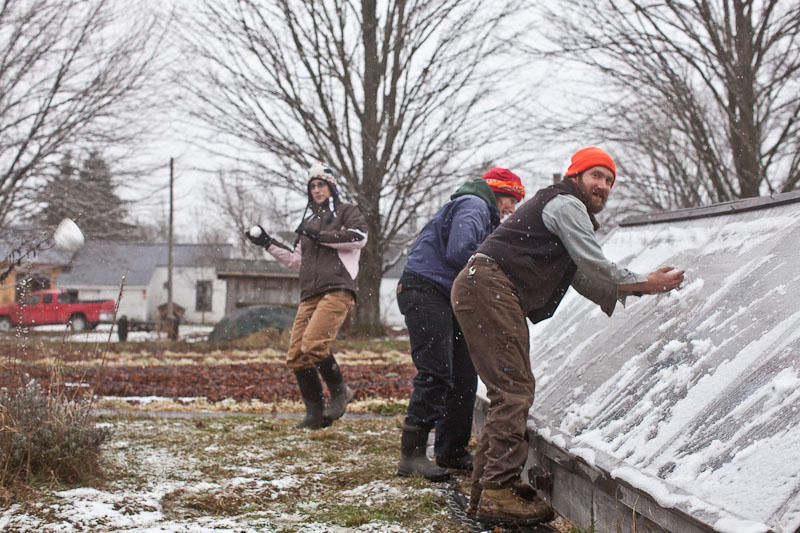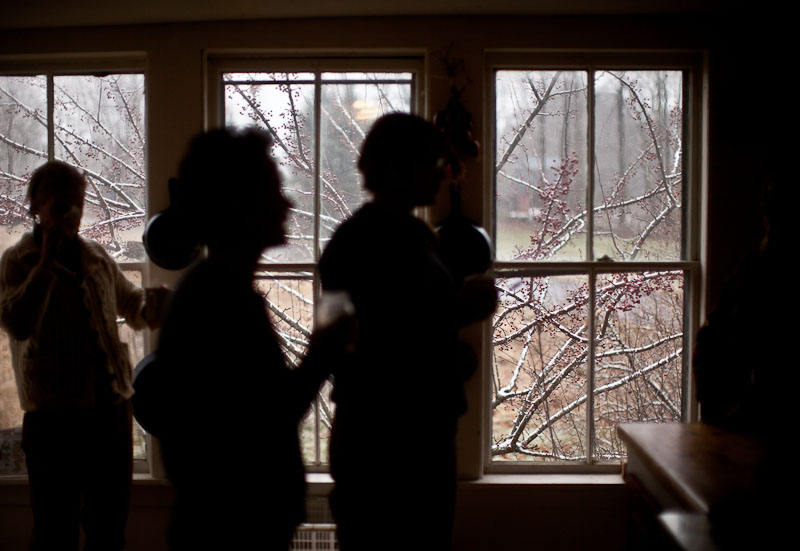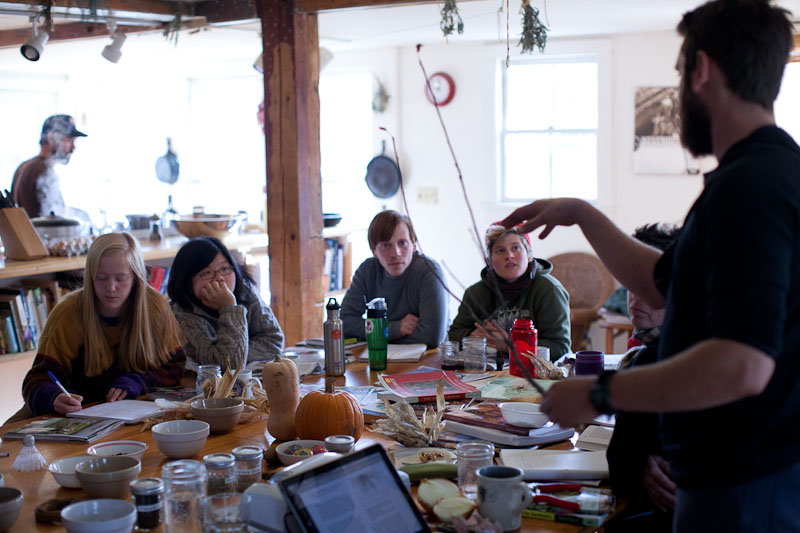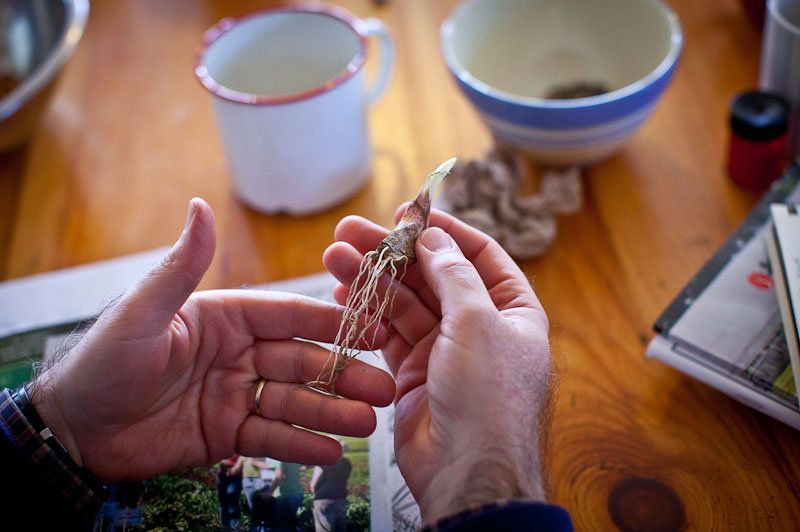The Stevie Wonder-ful World of Plants
 Thanksgiving is in the rear-view mirror and hunting season is now upon us, which means the roadsides winding along the forest edges of our farm have been lined with pickup trucks. Hunters have their own harvesting schedule and it coincides with the time of year when adult animals have finished raising their young, furbearing animals are sporting their most luxurious coats, and, in agricultural communities, farmers finally have time off from their on-farm responsibilities. For us at the Farm School, hunting is not part of our curriculum, but sharing the woods with hunters means that bright orange winter hats and bandanas have become the ‘in’ fashion accessory of the season.Snow has also started to descend, lightly for now, but enough to transform fully grown adults into giddy children. More than once this week, we’ve suspended work to accommodate spontaneous snowball fights.
Thanksgiving is in the rear-view mirror and hunting season is now upon us, which means the roadsides winding along the forest edges of our farm have been lined with pickup trucks. Hunters have their own harvesting schedule and it coincides with the time of year when adult animals have finished raising their young, furbearing animals are sporting their most luxurious coats, and, in agricultural communities, farmers finally have time off from their on-farm responsibilities. For us at the Farm School, hunting is not part of our curriculum, but sharing the woods with hunters means that bright orange winter hats and bandanas have become the ‘in’ fashion accessory of the season.Snow has also started to descend, lightly for now, but enough to transform fully grown adults into giddy children. More than once this week, we’ve suspended work to accommodate spontaneous snowball fights. And as life silently withdraws into the branches of the choke cherry tree outside our kitchen window, we too cozied up indoors with cups of tea and seed catalogues to busy ourselves with visions for the season ahead.But before we could talk long-day vs. short-day onions, Tyson (the head grower) sat us down for ‘the talk’.
And as life silently withdraws into the branches of the choke cherry tree outside our kitchen window, we too cozied up indoors with cups of tea and seed catalogues to busy ourselves with visions for the season ahead.But before we could talk long-day vs. short-day onions, Tyson (the head grower) sat us down for ‘the talk’. The plant sex talk, that is. And holy moly, plant sex is fascinating. So amazing, in fact, that Stevie Wonder released a two-disk album entitled “Journey Through the Secret Life of Plants,” which, rumor has it, was rose-scented. You have to appreciate that a blind man was moved to compose twenty songs about botany. But I played the title track for Dina, and after welling up with appreciation, she immediately proclaimed that if she won the lottery, she would have to buy up all the albums in existence so that Stevie would at least get rich, but then she’d have to burn them so we would no longer have to be embarrassed for him. Sadly, given our taste in music, Stevie’s idealism outstripped his execution.Among the many ‘holy sh*t!’ facts we picked up during our botany talk is that each variety of apple, such as a Granny Smith, is genetically identical to every other Granny Smith apple. All apple trees of a given type come from cuttings of a parent tree grafted onto rootstock, which is the only method of producing fruit that is true to its parent type. It turns out that apples blossoms can’t self-fertilize with pollen of their own variety and instead have to cross-pollinate with a different variety. This means the seeds inside a Granny Smith apple will grow a tree that will produce apples nothing like a Granny Smith. I love the idea that the apple trees we visit every fall are all actually parts of the Original Tree, which has escaped death through thousands of years propagation.
The plant sex talk, that is. And holy moly, plant sex is fascinating. So amazing, in fact, that Stevie Wonder released a two-disk album entitled “Journey Through the Secret Life of Plants,” which, rumor has it, was rose-scented. You have to appreciate that a blind man was moved to compose twenty songs about botany. But I played the title track for Dina, and after welling up with appreciation, she immediately proclaimed that if she won the lottery, she would have to buy up all the albums in existence so that Stevie would at least get rich, but then she’d have to burn them so we would no longer have to be embarrassed for him. Sadly, given our taste in music, Stevie’s idealism outstripped his execution.Among the many ‘holy sh*t!’ facts we picked up during our botany talk is that each variety of apple, such as a Granny Smith, is genetically identical to every other Granny Smith apple. All apple trees of a given type come from cuttings of a parent tree grafted onto rootstock, which is the only method of producing fruit that is true to its parent type. It turns out that apples blossoms can’t self-fertilize with pollen of their own variety and instead have to cross-pollinate with a different variety. This means the seeds inside a Granny Smith apple will grow a tree that will produce apples nothing like a Granny Smith. I love the idea that the apple trees we visit every fall are all actually parts of the Original Tree, which has escaped death through thousands of years propagation. And did you know that more living organisms abide in soil than in all other ecosystems combined? In fact, the biggest living organism on this planet is not the blue whale, but an 8,000-year-old, 2,200-acre large soil-inhabiting fungus in Oregon’s Blue Mountains that lives in harmony with the forest. The primary function of these organisms is to break down organic matter and make it available for new life. And without them, death on our planet would have the final say. Thanks to a force that we can’t see and don’t halfway understand, death and resurrection literally bring us the bread of new life in an ongoing process that happens right under our feet. Does this sound religious to anyone else?Before I risk offending the New Testament scholars out there, I’ll back off the eco-theology and close with some good old slapstick: yet another chapter in my ongoing, wholly un-symbiotic relationship with Mr. Marbles, our ram.
And did you know that more living organisms abide in soil than in all other ecosystems combined? In fact, the biggest living organism on this planet is not the blue whale, but an 8,000-year-old, 2,200-acre large soil-inhabiting fungus in Oregon’s Blue Mountains that lives in harmony with the forest. The primary function of these organisms is to break down organic matter and make it available for new life. And without them, death on our planet would have the final say. Thanks to a force that we can’t see and don’t halfway understand, death and resurrection literally bring us the bread of new life in an ongoing process that happens right under our feet. Does this sound religious to anyone else?Before I risk offending the New Testament scholars out there, I’ll back off the eco-theology and close with some good old slapstick: yet another chapter in my ongoing, wholly un-symbiotic relationship with Mr. Marbles, our ram. Patience, our milk cow, shares her winter corral with nine Border Leicester sheep and one moody and paranoid ram. This has become a problem at feeding time because Patience (who’s lactating and therefore has more dietary needs) requires the premium hay, known as second-cut hay, while the sheep are stuck with less desirable first-cut. Because we have no good system for feeding them separately, the sheep jostle for the good stuff, which so annoys Patience that she eventually gives up and stomps off to the yard, bellowing in frustration.My chore group was assigned to the sheep this week and one evening, we took on the challenge of devising more sustainable feeding system. Patience had outright rejected our first and second solutions, but we had a third one lined up for her approval. I ventured out to the yard to bring her back in, but unbeknownst to me, Mr. Marbles was hidden among the wooly hides and was patrolling his flock with his usual disproportionate amount of human distrust.As I took patience by the collar and coaxed her toward the open door of the barn, Mr. Marbles, sized me up, lowered his head and blasted my backside. I’ve described it like falling on your butt, except the ground comes to you.It didn’t really hurt, but it did make me mad. Marbles knocked three students off their feet last year and I wasn’t about to become his fourth victim. Thankfully, Patience doesn’t take any crap from Marbles so using her as a shield, we bulldozed our way past Marbles and back to the barn where I could show off our latest idea. But once inside, Patience took one sniff at our ‘solution’ returned to her pouting post outside, leaving me alone in the stall with Marbles. Seizing the opportunity, he lowered his head and charged, giving me just enough time to extend my leg and block his flat head solidly with the bottom of my boot. Marbles: one; Erik: one.
Patience, our milk cow, shares her winter corral with nine Border Leicester sheep and one moody and paranoid ram. This has become a problem at feeding time because Patience (who’s lactating and therefore has more dietary needs) requires the premium hay, known as second-cut hay, while the sheep are stuck with less desirable first-cut. Because we have no good system for feeding them separately, the sheep jostle for the good stuff, which so annoys Patience that she eventually gives up and stomps off to the yard, bellowing in frustration.My chore group was assigned to the sheep this week and one evening, we took on the challenge of devising more sustainable feeding system. Patience had outright rejected our first and second solutions, but we had a third one lined up for her approval. I ventured out to the yard to bring her back in, but unbeknownst to me, Mr. Marbles was hidden among the wooly hides and was patrolling his flock with his usual disproportionate amount of human distrust.As I took patience by the collar and coaxed her toward the open door of the barn, Mr. Marbles, sized me up, lowered his head and blasted my backside. I’ve described it like falling on your butt, except the ground comes to you.It didn’t really hurt, but it did make me mad. Marbles knocked three students off their feet last year and I wasn’t about to become his fourth victim. Thankfully, Patience doesn’t take any crap from Marbles so using her as a shield, we bulldozed our way past Marbles and back to the barn where I could show off our latest idea. But once inside, Patience took one sniff at our ‘solution’ returned to her pouting post outside, leaving me alone in the stall with Marbles. Seizing the opportunity, he lowered his head and charged, giving me just enough time to extend my leg and block his flat head solidly with the bottom of my boot. Marbles: one; Erik: one. I watched triumphantly as he slowly backed away figuring he had given up. But it soon became clear he was only giving himself room for a running start. He lurched – and I scrambled sideways, pitching myself over the wall, landing butt-first in Patience’s manger of untouched hay. Marbles stared at me through the slats of the stall, and if a ram could look satisfied, well – he did. My chore-mate Kate fell into hysterics as I pulled myself out of the tub and brushed hay from my pants.We have yet to come up with a working solution for Patience – I guess that’s this week’s work. And as for Marbles, I’m calling it a draw.For more photos of my bestie, Marbles and the rest of the week in photos, click HERE.
I watched triumphantly as he slowly backed away figuring he had given up. But it soon became clear he was only giving himself room for a running start. He lurched – and I scrambled sideways, pitching myself over the wall, landing butt-first in Patience’s manger of untouched hay. Marbles stared at me through the slats of the stall, and if a ram could look satisfied, well – he did. My chore-mate Kate fell into hysterics as I pulled myself out of the tub and brushed hay from my pants.We have yet to come up with a working solution for Patience – I guess that’s this week’s work. And as for Marbles, I’m calling it a draw.For more photos of my bestie, Marbles and the rest of the week in photos, click HERE.

